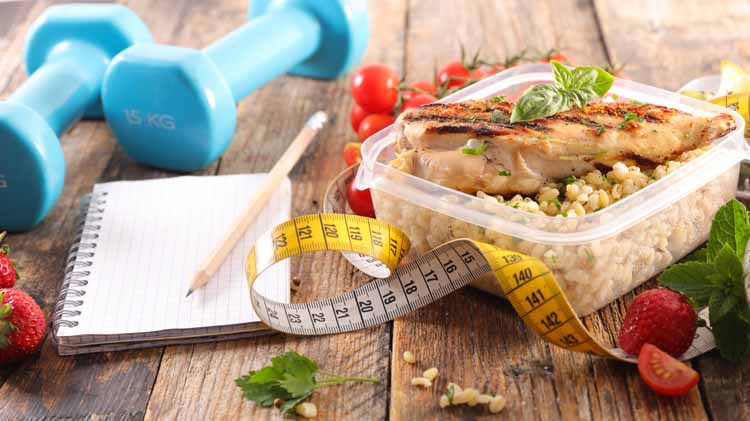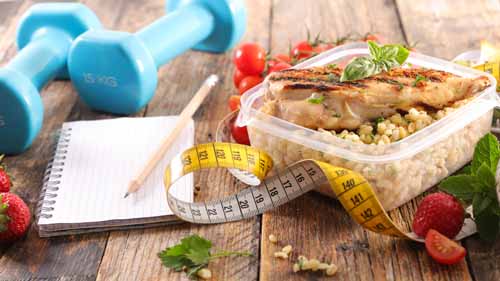The 7 Most Popular Diets: How Do They Compare for Weight Loss?
Updated by Stephen Anton PhD on June 25th, 2020

In today’s society of weight-loss fads, many wonder what diet is best and why they should give it a shot. All of the diets say that they are the best, but how do they compare?
The top seven most popular diets were chosen by a systematic study to look at the scientific evidence of the effects of their weight loss outcomes (1).
Do they give you what is promised in the end?
How do they help with weight loss or muscle gains?
Below are the basics of these seven diets to showcase their plans and how they work in the body. Each has its positives and negatives to the world of weight loss.
1) Atkins Diet
The Atkins diet is a low-carb diet, usually recommended for weight loss. Proponents of this diet claim that you can lose weight while eating as much protein and fat as you want, as long as you avoid foods high in carbs.
Over the years, many studies have shown that low-carb diets without needing calorie counting are effective for weight loss and can lead to various health improvements.
The Atkins diet has four different phases:
Phase 1: Induction
Start with under 20 grams of carbs per day for two weeks
Eat high-fat, high-protein, with low-carb vegetables like leafy greens
These steps kick-start the weight loss
Phase 2: Balancing
Slowly add more nuts, low-carb vegetables, and small amounts of fruit back to your diet
Phase 3: Fine-tuning
When you’re very close to your goal weight, add more carbs to your diet until weight loss slows down
Phase 4: Maintenance
Here you can eat as many healthy carbs as your body can tolerate without regaining weight
Many skip the induction portion and start with plenty of fruits and vegetables to support a healthy lifestyle.
2) Dash Diet
Dietary Approaches to Stop Hypertension (DASH) is an eating plan to lower or control high blood pressure. The DASH diet features menus with plenty of whole grains, vegetables, poultry, fish, fruits, and nuts.
What is the goal?
Reduce your sodium intake and instead eat a variety of foods that contain blood pressure-lowering nutrients like magnesium, potassium, and calcium.
Some tips are to snack on low sodium foods like nuts or unsalted popcorn. You can also include fruit for a snack or dessert. Opting for low-fat or skim dairy will benefit this approach as well.
3) Glycemic-Index Diet
The glycemic index, or GI, measures how a carbohydrate-containing food raises blood glucose.
Foods are ranked based on how they compare to a reference food — either glucose or white bread.
Low GI Foods (55 or less):
Sweet potato, corn, yam, lima/butter beans, peas, legumes, and lentils
100% stone-ground whole wheat or pumpernickel bread
Oatmeal (rolled or steel-cut), oat bran, muesli
Most fruits, non-starchy vegetables, and carrots
Pasta, converted rice, barley, bulgar
Medium GI Foods (56-69):
Brown, wild or basmati rice, couscous
Whole wheat, rye, and pita bread
Quick oats
High GI Foods (70 or more):
Short grain white rice, rice pasta, macaroni, and cheese from mix
Corn flakes, puffed rice, bran flakes, instant oatmeal
Pretzels, rice cakes, popcorn, saltine crackers
Russet potato, pumpkin
Melons and pineapple
White bread or bagel
Fat and fiber tend to lower the GI value of a food. The more processed it is, the higher the GI value, in general.
However, this is not true of all foods.
4) Mediterranean Diet
If you’re looking for a heart-healthy eating plan, the Mediterranean diet might be right for you.
The Mediterranean diet incorporates the basics of healthy eating — plus a splash of flavorful olive oil and perhaps a glass of red wine — among other components characterizing the traditional cooking style of countries bordering the Mediterranean Sea.
Most healthy diets include whole grains, vegetables, fish, and fruit. Most Mediterranean diets limit unhealthy fats.
While these parts of a healthy diet are tried-and-true, subtle variations or differences in proportions of certain foods may make a difference in your risk of heart disease.
This diet is popular for lowering low-density lipoprotein (LDL) levels of cholesterol, the “bad” cholesterol.
The Mediterranean diet emphasizes:
Eating primarily plant-based foods, such as fruits and vegetables, whole grains, legumes, and nuts
Replacing butter with healthy fats such as olive oil and canola oil
Using herbs and spices instead of salt to flavor foods
Limiting red meat to no more than a few times a month
Eating fish and poultry at least twice per week
Enjoying meals with family and friends
Drinking red wine in moderation (optional)
Getting plenty of exercise
5) Ornish Diet
Ornish Lifestyle Medicine has been scientifically proven to reverse the progression of even severe cases of coronary heart disease, hypercholesterolemia, high blood pressure, and type 2 diabetes.
It has even shown some results in slowing cancer growth. It is a specific diet plan for each individual based on genes.
There is a focus on eating good proteins, carbs, and fats and avoids eating bad proteins, carbs, and fats. There should also be a focus on eating foods in their natural form as they are found in nature and leaving out processed foods in any way.
Small frequent meals spread throughout the day will help you avoid hunger and keep your energy levels constant.
Calories are unrestricted for most in this plan unless you are trying to lose weight, and then there are some restrictions.
6) Paleolithic Diet
A paleo diet aims to return to a way of eating that’s more like what early humans ate. The diet consists of foods that in the past could be obtained by hunting and gathering.
The aim is to limit foods that became common when farming emerged about 10,000 years ago. The diet reasons that the human body is genetically mismatched to the modern diet that emerged with farming practices.
What foods to eat:
Fish, especially those rich in omega-3 fatty acids, such as salmon, mackerel, and albacore tuna
Oils from fruits and nuts, such as olive oil or walnut oil
Lean meats, especially grass-fed animals or wild game
Nuts and seeds
Vegetables
Fruits
What foods to avoid:
Legumes, such as beans, lentils, peanuts, and peas
Grains, such as wheat, oats, and barley
Highly processed foods in general
Dairy products
Refined sugar
Potatoes
Salt
7) Zone Diet
The Zone diet doesn’t promise dramatic weight loss and usually results in 1 to 2 lbs in the first week. It is designed for long term loss and to reduce inflammation.
On the Zone diet, you get three meals and two snacks a day.
Each meal is a mix of:
Small amount of “good” fat, like olive oil, almonds, and avocado
Low-fat protein, like skinless chicken, turkey, or fish
Carbs (mostly fruits and veggies)
No food is completely banned, but if you’re a carb-lover, you may find getting used to the Zone plan challenging. It encourages you to think of bread, pasta, grains, and other starches as condiments rather than main or even side dishes.
Every meal on the Zone plan has the same proportions, 30% protein, 30% fats, and 40% carbs.
The Winner: Atkins Diet
Most of the diets showed weight loss results, but Atkins had the most short-term results, long-term results, and clinical trials.
Overall, you should select a diet that most aligns with your specific goals and needs. It all comes down to consistency and following the guidelines as well as including exercise.
The 7 Most Popular Diets: How Do They Compare for Weight Loss?
Updated by Stephen Anton PhD on June 25th, 2020

In today’s society of weight-loss fads, many wonder what diet is best and why they should give it a shot. All of the diets say that they are the best, but how do they compare?
The top seven most popular diets were chosen by a systematic study to look at the scientific evidence of the effects of their weight loss outcomes (1).
Do they give you what is promised in the end?
How do they help with weight loss or muscle gains?
Below are the basics of these seven diets to showcase their plans and how they work in the body. Each has its positives and negatives to the world of weight loss.
1) Atkins Diet
The Atkins diet is a low-carb diet, usually recommended for weight loss. Proponents of this diet claim that you can lose weight while eating as much protein and fat as you want, as long as you avoid foods high in carbs.
Over the years, many studies have shown that low-carb diets without needing calorie counting are effective for weight loss and can lead to various health improvements.
The Atkins diet has four different phases:
Phase 1: Induction
Start with under 20 grams of carbs per day for two weeks
Eat high-fat, high-protein, with low-carb vegetables like leafy greens
These steps kick-start the weight loss
Phase 2: Balancing
Slowly add more nuts, low-carb vegetables, and small amounts of fruit back to your diet
Phase 3: Fine-tuning
When you’re very close to your goal weight, add more carbs to your diet until weight loss slows down
Phase 4: Maintenance
Here you can eat as many healthy carbs as your body can tolerate without regaining weight
Many skip the induction portion and start with plenty of fruits and vegetables to support a healthy lifestyle.
2) Dash Diet
Dietary Approaches to Stop Hypertension (DASH) is an eating plan to lower or control high blood pressure. The DASH diet features menus with plenty of whole grains, vegetables, poultry, fish, fruits, and nuts.
What is the goal?
Reduce your sodium intake and instead eat a variety of foods that contain blood pressure-lowering nutrients like magnesium, potassium, and calcium.
Some tips are to snack on low sodium foods like nuts or unsalted popcorn. You can also include fruit for a snack or dessert. Opting for low-fat or skim dairy will benefit this approach as well.
3) Glycemic-Index Diet
The glycemic index, or GI, measures how a carbohydrate-containing food raises blood glucose.
Foods are ranked based on how they compare to a reference food — either glucose or white bread.
Low GI Foods (55 or less):
Sweet potato, corn, yam, lima/butter beans, peas, legumes, and lentils
100% stone-ground whole wheat or pumpernickel bread
Oatmeal (rolled or steel-cut), oat bran, muesli
Most fruits, non-starchy vegetables, and carrots
Pasta, converted rice, barley, bulgar
Medium GI Foods (56-69):
Brown, wild or basmati rice, couscous
Whole wheat, rye, and pita bread
Quick oats
High GI Foods (70 or more):
Short grain white rice, rice pasta, macaroni, and cheese from mix
Corn flakes, puffed rice, bran flakes, instant oatmeal
Pretzels, rice cakes, popcorn, saltine crackers
Russet potato, pumpkin
Melons and pineapple
White bread or bagel
Fat and fiber tend to lower the GI value of a food. The more processed it is, the higher the GI value, in general.
However, this is not true of all foods.
4) Mediterranean Diet
If you’re looking for a heart-healthy eating plan, the Mediterranean diet might be right for you.
The Mediterranean diet incorporates the basics of healthy eating — plus a splash of flavorful olive oil and perhaps a glass of red wine — among other components characterizing the traditional cooking style of countries bordering the Mediterranean Sea.
Most healthy diets include whole grains, vegetables, fish, and fruit. Most Mediterranean diets limit unhealthy fats.
While these parts of a healthy diet are tried-and-true, subtle variations or differences in proportions of certain foods may make a difference in your risk of heart disease.
This diet is popular for lowering low-density lipoprotein (LDL) levels of cholesterol, the “bad” cholesterol.
The Mediterranean diet emphasizes:
Eating primarily plant-based foods, such as fruits and vegetables, whole grains, legumes, and nuts
Replacing butter with healthy fats such as olive oil and canola oil
Using herbs and spices instead of salt to flavor foods
Limiting red meat to no more than a few times a month
Eating fish and poultry at least twice per week
Enjoying meals with family and friends
Drinking red wine in moderation (optional)
Getting plenty of exercise
5) Ornish Diet
Ornish Lifestyle Medicine has been scientifically proven to reverse the progression of even severe cases of coronary heart disease, hypercholesterolemia, high blood pressure, and type 2 diabetes. It has even shown some results in slowing cancer growth.
It is a specific diet plan for each individual based on genes.
There is a focus on eating good proteins, carbs, and fats and avoids eating bad proteins, carbs, and fats. There should also be a focus on eating foods in their natural form as they are found in nature and leaving out processed foods in any way.
Small frequent meals spread throughout the day will help you avoid hunger and keep your energy levels constant.
Calories are unrestricted for most in this plan unless you are trying to lose weight, and then there are some restrictions.
6) Paleolithic Diet
A paleo diet aims to return to a way of eating that’s more like what early humans ate. The diet consists of foods that in the past could be obtained by hunting and gathering.
The aim is to limit foods that became common when farming emerged about 10,000 years ago. The diet reasons that the human body is genetically mismatched to the modern diet that emerged with farming practices.
What foods to eat:
Fish, especially those rich in omega-3 fatty acids, such as salmon, mackerel, and albacore tuna
Oils from fruits and nuts, such as olive oil or walnut oil
Lean meats, especially grass-fed animals or wild game
Nuts and seeds
Vegetables
Fruits
What foods to avoid:
Legumes, such as beans, lentils, peanuts, and peas
Grains, such as wheat, oats, and barley
Highly processed foods in general
Dairy products
Refined sugar
Potatoes
Salt
7) Zone Diet
The Zone diet doesn’t promise dramatic weight loss and usually results in 1 to 2 lbs in the first week. It is designed for long term loss and to reduce inflammation.
On the Zone diet, you get three meals and two snacks a day.
Each meal is a mix of:
Small amount of “good” fat, like olive oil, almonds, and avocado
Low-fat protein, like skinless chicken, turkey, or fish
Carbs (mostly fruits and veggies)
No food is completely banned, but if you’re a carb-lover, you may find getting used to the Zone plan challenging. It encourages you to think of bread, pasta, grains, and other starches as condiments rather than main or even side dishes.
Every meal on the Zone plan has the same proportions, 30% protein, 30% fats, and 40% carbs.
The Winner: Atkins Diet
Most of the diets showed weight loss results, but Atkins had the most short-term results, long-term results, and clinical trials.
Overall, you should select a diet that most aligns with your specific goals and needs. It all comes down to consistency and following the guidelines as well as including exercise.

Get the Beginner’s Guide to Intermittent Fasting
Take advantage of this FREE PDF and learn the basics of intermittent fasting.

Get the Beginner’s Guide to Intermittent Fasting
Take advantage of this 100% free PDF and learn the basics of intermittent fasting.

Get the Beginner’s Guide to Intermittent Fasting
Take advantage of this FREE PDF and learn the basics of intermittent fasting.









